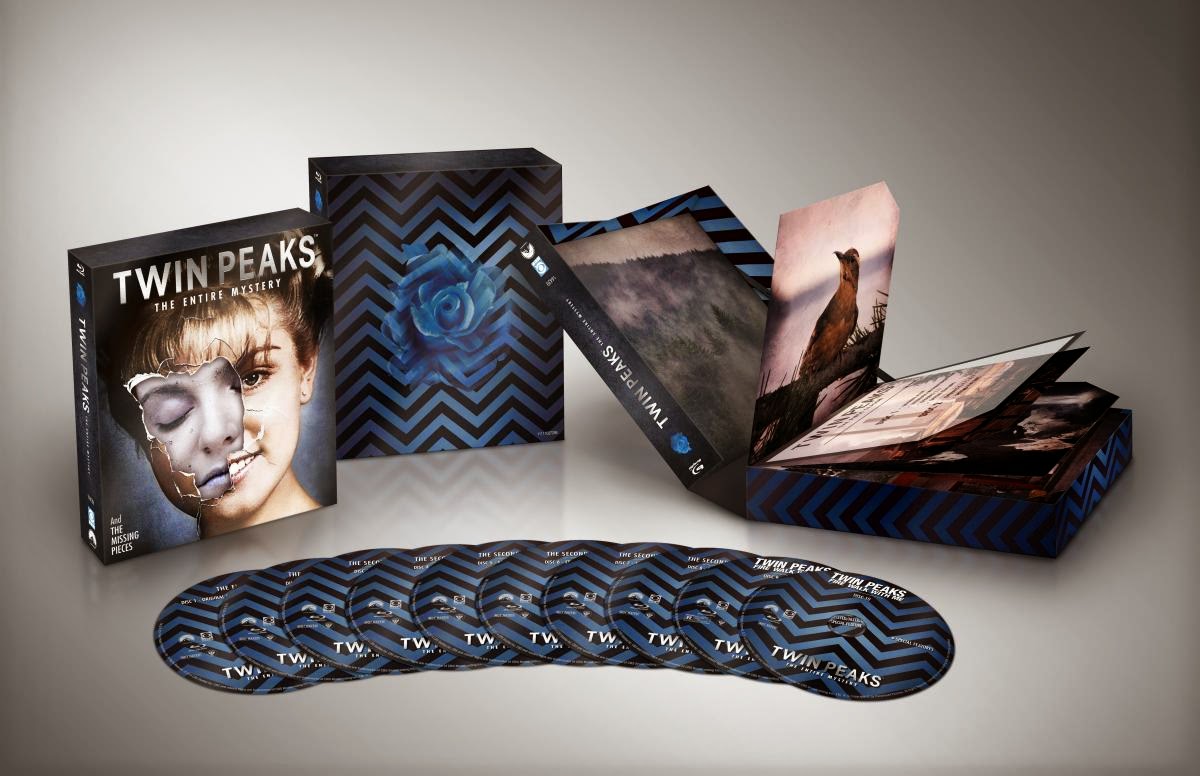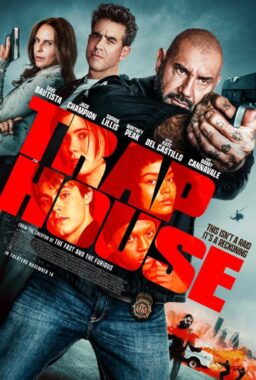As TV progresses through what is arguably its golden era, it
has become somewhat clichéd to reference the “shows that laid the foundation”
for that era. “Dude, ‘The Sopranos’ changed everything.”
Or perhaps you go back to “Hill Street Blues,” “NYPD Blue,” or even “Oz.” All
major game-changers. And yet I speak personally when I tell you that, for me,
one of the most influential creative properties of any form—TV, film, theatre, literature—was
David Lynch’s “Twin Peaks,” recently released in a gorgeously remastered
Blu-ray box set from Paramount, complete with every episode that aired on ABC
and, gloriously, “Twin Peaks: Fire Walk with Me,” the film that defied the
expectations of the show’s remaining fans by refusing to answer so many of
their questions. Deleted scenes from the feature film add new layers to the
mystery without really resolving anything; merely bringing us deeper into the
forest of Lynch’s vision. “Twin Peaks” hit me at a time when I was young enough
to just be straying off the popular path of the mainstream. And unlike a lot of
the nostalgic properties of our youth, it has held up perfectly. It’s still so
wildly inventive, smart, and unapologetically bizarre. And while it may have taken longer than any of us expected for it to get the appropriate Blu-ray treatment, the wait appears to have been worth it.
It’s tempting to argue that “Twin Peaks” didn’t really
change TV as much as some other programs, including the ones mentioned in the
previous paragraph, because it was so defiantly unique as to avoid copycats. It’s
relatively easy to try and make another “LOST,” another “Sopranos,” another “Dexter”—making
another “Twin Peaks”? Yeah, good luck with that. I always kind of considered “Twin Peaks” more of an outlier than an influencer. And yet, watching the series
premiere again in glorious, perfectly-balanced HD, I’m struck by how much it looks like a program that could
air in 2014, with only a few fashion and décor updates. Lynch’s style, which
often tracked its actors in a way that felt so much more like film than
traditional ‘90s television, reminds one of recent programs like “The Killing,” “Fargo”
and “The Americans” in both its economy of visual language and strong focus on
setting as a character, and the application of the auteur theory to the small screen arguably started here.

Visually, “Twin Peaks” is striking from the very first episode. Lynch is constantly cutting to iconic images of the stage he’s
trying to set. When Sarah Palmer (Grace Zabriskie) looks for her dead daughter Laura (Sheryl Lee) in the
morning, we get a few shots of the ceiling fan. Why? Lynch liked the visual (and he would return to that damn fan throughout the series and even in the film).
For Ben Horne’s (Richard Beymer) first scene, the stage is set with a close-up
of a fireplace. Why? Again, it struck Lynch as a way to represent the Great
Northern Hotel. The way the next scene is composed, as Sarah calls Leland (Ray
Wise) to see if he knows their daughter’s whereabouts, and we see Sheriff
Truman (Michael Ontkean) through the windows behind him is not only perfect, it’s
unlike anything that anyone was even trying in the early ‘90s, when the highest
rated dramas on TV were “Murder, She Wrote,” “Matlock,” and “L.A. Law.” This is the kind of visual composition to which we are accustomed in 2014 but was a breakthrough in 1990. Underneath it all, Lynch layers that perfect Angelo
Badalamenti score, one of the best in TV history, which plays with
melodramatic, soap operatic themes but adds its own layer of malevolence.
“Twin Peaks” was also a bridge to unite film and TV lovers
in a way that hasn’t been fully appreciated. Not only was a major voice in film
deigning to lower himself to the still-considered inferior form of TV but he
wasn’t compromising his artistic interests in the slightest when he did so. The
trend of film directors moving to TV seems so remarkably common today with
filmmakers like Martin Scorsese and Steven Soderbergh working on small-screen
projects but it was remarkably rare in 1990. And there was no doubt, especially
for fans of “Blue Velvet,” that David Lynch was working in his thematic
wheelhouse. He was again playing with Americana, the pitch-black heart behind
the white picket fence. So many of the characters and themes of “Twin Peaks”
play off cinematic and pop culture archetypes from the anachronistic James Dean wannabes
(trust me, I was around that age in 1991 and no one wore as much leather or put
as much grease in their hair as Bobby Briggs and James Hurley) to the apple pie
& coffee that became iconic to the fact that the Sherriff is named Harry
Truman. Even the very form—the soap opera—is an American one through and
through. This was the same world in which Jeffrey Beaumont (who also lived in a
logging town) of “Blue Velvet” lived and it was remarkable to see a filmmaker
who wasn’t adjusting his vision for the small screen but expanding on it.

Of course, then it all went to Hell. As is well known by
now, “Twin Peaks” faded out as quickly as it rose to fame, as more and more
people grew frustrated by the fact that David Lynch was always more interested
in questions than answers. Even then I hoped he would never solve the murder of Laura
Palmer, and I think the legend of the show would actually be stronger if he had
stuck to that idea. Like a program that falters when the two sexually-tense
leads finally get together, the end of the Laura Palmer arc on “Twin Peaks” was
the end of the show for so many people. And it didn’t help that Lynch and
company clearly didn’t know what to do next. The show spun in still-fascinating
circles for a few episodes before arguably the most bizarre series ending of
all time. “Twin Peaks” was over and it was still unclear as to if it would really
have an impact on the medium. It obviously has but it took time for it to be
felt, almost as if it was the creative voices raised on the show who had it
influence their own output more than the other works of the ‘90s and even most
of the ‘00s. It took a generation.
And now that generation has “The Entire Mystery.” Paramount
has lovingly restored the episodes, which look great in HD. I actually forgot
that the show wasn’t widescreen—it was always so cinematic in my memory. And
the supplemental material is strong, including Log Lady intros (yes, there was
a time when the Log Lady was actually something of a celebrity), the
international version of the pilot that (sorta) stood as a standalone TV movie,
and, of course, the draw for a lot of Lynch fans, “Fire Walk with Me” in HD
with deleted scenes.

How has “Twin Peaks: Fire Walk with Me” held up? Being a fan
of “Twin Peaks” up to the bitter end, I somewhat joined in the chorus of
disappointment that greeted the film in 1992 (which was greeted with boos at its Cannes premiere). You canceled my favorite show and
THIS is what I get? Agent Cooper is a supporting character, Lara Flynn Boyle
& Sherilyn Fenn aren’t even in the thing, and it raises more questions than
it answers! Great. Thanks for nothing. Seeing it now, I have a completely
different response. Like so much of Lynch’s best works, it plays like a dream,
complete with missing characters, rough edges, and incomplete thoughts.
Lynch has said that he made “Fire Walk with Me” because he
couldn’t leave the world of Twin Peaks and it’s that aspect of the film that
still fascinates. First, is this a prequel or a sequel? It was advertised as
something that would answer the questions of Laura Palmer’s life before her
murder but it also tries to work with the loose ends after season two (and the
deleted scenes do even more of that). Lynch’s film is defiantly uninterested in
meeting audience expectations. It opens with new characters, including Lynch
himself and an Agent played by Chris Isaak, who was pretty well known to
viewers as a pop star at this time. Imagine going to see a “LOST” movie and spending the first act with Justin Timberlake to get some idea how annoyed fans of the show were in 1992.
Ultimately, this is Lynch revisiting a world, an aesthetic, and not a
plotline or a narrative or even characters. It’s him working thematically (again in the pitch-black darkness of small town normalcy) and not in black and
white, and it is further proof of his belief that it is the murder that
matters and not the murderer. I still have some basic composition and structure
issues with “Fire Walk with Me” (it can sometimes be Lynch at his most
meandering) but revisiting it so much further from the shadow of the program
that inspired it allows it to be seen in an entirely different light. It is
part-sequel, part-prequel, part-fan-fiction, part-response, and part-dream.
Some of those parts don’t work but they’re never less than fascinating. It’s such a fantastic release that it makes
me want to see the long-rumored “Mulholland Drive” Special Edition finally released on Blu-ray stateside even more. You hear me, Criterion?
Before you head out to get your own copy, it should be noted
that all of the special features from the definitive “Gold Box” DVD release of
2007 have been given the import treatment, joined by new conversations with
Lynch and the Palmer family and those aforementioned deleted scenes, which are
enough for real fans of “Twin Peaks” to pick this up. I’ve heard some already
complain that they don’t provide the conclusions or enough of the supporting
characters that they thought were missing from “Fire Walk with Me.” I can say
with some confidence that David Lynch doesn’t care. And you shouldn’t either.












